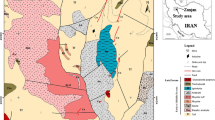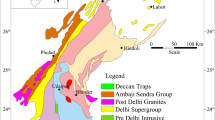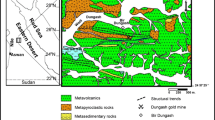Abstract
The metalized quartz veins is located 5 km west of the Iraqi-Iran border in the Qandil range. The quartz veins included sulfide and oxide ore minerals which mostly occur in the form of open-space filling texture. The polymetallic mesothermal quartz veins are hosted by marble and phyllite rocks. Within these veins, multiphase, open-space filling and crustiform, bedding to massive textures with pyrite, sphalerite, galena, chalcopyrite,galena, sphalerite, tenorite, azurite, and malachite are observed. Selected samples were analyzed by using ore microscopy and electron probe micro analyzer (EPMA) and scanning electron microscope (SEM). Ore minerals show replacement textures. The paragenesis diagram was made from a careful study of polished sections and three stages have been identified including pre-stage mineralization, mineralization, and post-mineralization stages.
Fluid inclusion microthermometric analysis of 15 primary inclusions of quartz veins indicated that ore mineralization at the studied area were formed by a mesothermal, low to medium density, and dilute NaCl-type fluid system. The source of the fluid is mostly metamorphic which became mixed with other fluids later. Hydrothermal fluids of the selected studied area were classified into two groups based on microthermometry study; the first group had a higher homogenization temperature (335.5 to 386.8 °C) than the second group (194.1 to 298.5 °C), with a small difference in salinity between them. Nearly each group has different complexes including chloride and sulfide complexes respectively. The results of stable sulfur isotope of the ore minerals (chalcopyrite and sphalerite) confirmed the sedimentary and/or metamorphic origin of the ore mineralization.

















Similar content being viewed by others
References
Agard PJ, Omrani L, Jolivet, Mouthereau F (2005) Convergence history across Zagros (Iran):Constraints from collisional and earlier deformation. Int J Earth Sci 94(3):401–419
Alavi M (1994) Tectonics of the Zagros orogenic belt of Iran: new data and interpretation. J Tectonophys 229(3):211–238
Alavi M (2004) Regional stratigraphy of the Zagros fold-thrust belt of Iran and its proforeland evolution. Am J Sci 304(1):1–20
Aliyari F, Rastad E, Mohajjel M, Arehart GB (2009) Geology and geochemistry of D–O–C isotope systematics of the Qolqoleh gold deposit, northwestern Iran: implications for ore genesis. Ore Geol Rev 36(4):306–314
Al-Qayim B, Omer A, Koyi H (2012) Tectonostratigraphic overview 566 of the Zagros 567 Suture Zone, Kurdistan Region, Northeast Iraq. GeoArabia 17:109–156
Bazargani-Guilani K, Rabiei M, Mehrabi B (2013) Effects of host rock mineralogical composition and sedimentary facies on development of geochemical halos in Shahmirzad Pb-Zn deposits, central Alborz, Iran. J Geochem Explor 124:155–165
Bodnar RJ (1983) A method of calculating fluid inclusion volumes based on vapor bubble diameters and PVTX properties of inclusion fluids. Econ Geol 78(3):535–542
Bodnar RJ (1993) Revised equation and table for determining the freezing point depression of H2O-NaCl solutions. Geochim Cosmochim Acta 57(3):683–684
Bolton C M G (1955) Report on the geology and economic prospects of the Rowanduz area. Site Inv. Co. report. NIMCO Library. Baghdad
Buday T (1980) The regional geology of Iraq, stratigraphy and paleogeography, Dar AL-Kuttib Pub. House. University of Mosul, Iraq. 445p
Cairns CJ, McQueen KG, Leah PA (2001) Mineralogical controls on element dispersion in regolith over two mineralised shear zones near the Peak, Cobar, New South Wales. J Geochem Explor 72(1):1–21
Daniel M, Darcy B, Bodnar RJ (2017) Mineralogical, petrographic and fluid inclusion evidence for the link between boiling and epithermal Ag-Au mineralization in the La Luz area, Guanajuato Mining District, México. Ore Geol Rev 89:143–170
Ghasemi A, Talbot CJ (2006) A new tectonic scenario for the Sanandaj–Sirjan Zone (Iran). J Asian Earth Sci 26(6):683–693
Goldstein RH (2003) Chapter two: Petrographic analysis of fluid inclusions, In Fluid inclusions analysis and interpretation edited by I. Samson, A. Anderson, & D. Marshall, eds. Mineral. Assoc. Can., Short Course Ser. 32, 9–53
Hanor JS (2000) Barite–celestine geochemistry and environments of formation. Rev Mineral Geochem 40(1):193–275
Hoefs J (2009) Stable isotope geochemistry. Springer-Verlag, Berlin
Ismail S. A, Ali S A, Nutman A P, Bennett VC, Jones B G. (2016) The Pushtashan juvenile suprasubduction zone assemblage of Kurdistan (northeastern Iraq): a cretaceous (Cenomanian) Neo-Tethys missing link. Geosci Front
Jassim S.Z, Goff JC eds. (2006) Geology of Iraq, DOLIN, sro, distributed by Geological Society of London
Kalogeropoulos SI (1982) Chemical sediments inthe hanging wall of volcanogenic massive sulfide deposits. Ph.D. thesis, Univ. Toronto, 488 p
Kant W, Warmada IW, Idrus A, Setijadji LD, Watanabe K (2014) Ore mineralogy and mineral chemistry of pyrite, galena, and sphalerite at Soripesa prospect area, Sumbawa Island, Indonesia. J Appl Geol 4(1):1–14
Kesler SE (2005) Ore-forming fluids. Elements 1(1):13–18
Kuhanestani NM, Mohammadi BM, Alderton DHM, Tabatabaei SH, Bagheri H (2014) Mineralogical and geochemical studies on the Gowd-e-Morad (Ni, Co, As–Cu) mineral deposit Anarak (central Iran). Arab J Geosci 7(11):4779–4791
Kullerud G (1969) The lead-sulfur system. Am J Sci 267:233–256
Lianxing G, McClay KR (1992) Pyrite deformation in stratiform lead-zinc deposits of the Canadian Cordillera. Mineral Deposita 27(3):169–181
Lusk J, Calder BOE (2004) The composition of sphalerite and associated sulfides in reactions of the Cu-Fe-Zn-S, FeZn-S and Cu-Fe-S systems at 1 bar and temperatures between 250 and 535°C. Chem Geol 203:319–345
McClay KR, Ellis PG (1983) Deformation and recrystallization of pyrite. Mineral Mag 47(4):527–538
Mohajjel M, Fergusson CL (2000) Dextral transpression in Late Cretaceous continental collision, Sanandaj–Sirjan zone, western Iran. J Struct Geol 22(8):1125–1139
Nielsen H (1979) Sulfur isotopes. In: Jager E, Hunziker J (eds) Lectures in isotope geology. Springer, Berlin, pp 283–312
Ohmoto H (1986) Stable isotope geochemistry of ore deposits. Rev Mineral Geochem 16(1):491–559
Ohmoto H, Rye RO (1979) Isotopes of sulfur and carbon. In: Barnes HL (ed) Geochemistry of hydrothermal ore deposits, 2nd edn. John Wiley and Sons, New York, pp 509–567
Phillips GN, Williams PJ, De Jong G (1994) The nature of metamorphic fluids and significance for metal exploration. Geol Soc Lond, Spec Publ 78(1):55–68
Pirajno F (2009) Hydrothermal processes associated with meteorite impacts. In: Hydrothermal Processes and Mineral Systems. Springer, Dordrecht, pp 1097–1130
Pouchou JL, Pichoir F (1991) Quantitative analysis of homogeneous or stratified micro volumes applying the model “PAP”. In: Electron probe quantitation, Springer US, pp. 31–75
Ralica S, Vassilka M, Aberra M (2017) Ore petrology, hydrothermal alteration, fluid inclusions, and sulfur stable isotopes of the Milin Kamak intermediate sulfidation epithermal Au-Ag deposit in Western Srednogorie, Bulgaria. Ore Geol Rev 88:400–415
Ramdohr P (2013) The ore minerals and their intergrowths. Elsevier
Roedder EW (1958) Technique for the extraction and partial chemical analysis of fluid-filled inclusions from minerals. Econ Geol 53(3):235–269
Roedder E (1984) Fluid inclusions. Mineral Soc Am Rev Mineral 12:644
Seal RR II (2006) Sulfur isotope geochemistry of sulfide minerals. Rev Mineral Geochem 61:633–677
Sharland PRR, Archer DM, Casey RB, Davies SH, Hall AP, Heward AD, Horbury SMD (2001) Arabian Plate sequence stratigraphy, GeoArabia Special Publication 2, Gulf Petro Link, Bahrain, 371 p., with 3 charts
Sissakian VK (1997) Geological map of Arbeel and Mahabad Quadrangles Sheets, NJ 38-14 and NJ 8-15 Scale 1:250000. Geological survey and mining, Iraq
Wilkinson JJ (2001) Fluid inclusions in hydrothermal ore deposits. Lithos 55:229–272
Acknowledgments
We are grateful to Professor Dr. Harald G. Dill, Federal Institute for Geosciences and Natural Resources/Hannover, for his insightful suggestions and comments. We are indebted to the three anonymous referees for their constructive and critical reviews, which greatly helped us to improve this paper. We are particularly grateful to the laboratory of the Institute of Mineralogy and Geology, University of Miskolc, Hungary, for doing EPMA and SEM analysis.
Author information
Authors and Affiliations
Corresponding author
Rights and permissions
About this article
Cite this article
Mirza, T.A., Rashid, S.G. Mineralogy, Fluid inclusions and stable isotopes study constraints on genesis of sulfide ore mineral, Qaladiza area Qandil Series, Iraqi Kurdistan Region. Arab J Geosci 11, 146 (2018). https://doi.org/10.1007/s12517-018-3490-x
Received:
Accepted:
Published:
DOI: https://doi.org/10.1007/s12517-018-3490-x




